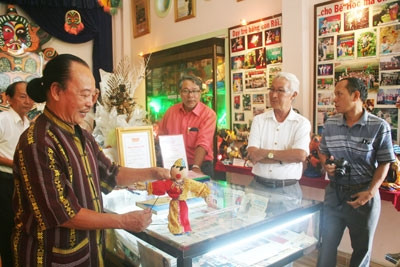Hanoi (VNA/VNS) – At the age of 75, artist Duong Van Hoc, who is well known as a pioneer in contemporary solo puppetry in Vietnam, is still busy performing, teaching and writing about puppetry and managing a small “puppetry museum” in the coastal city of Nha Trang in Khanh Hoa Province.
Early this year, his private “Contemporary Solo Puppetry Museum”, the first of its kind in the country, was opened at his house on 92B Duong Hien Quyen Street, Nha Trang City.
The museum is said to be a long-nurtured dream of Hoc who has identified himself with puppetry for over 30 years.
During the early stage of his career, Hoc used to work as a dance scriptwriter and stage director. In 1984, he began working at the Vietnam Puppetry Theater where his passion for the art blossomed.
He pioneered and introduced contemporary solo puppetry in 1992, and so far is the only local pursuer of the art.
His newly-established “museum” has a modest area of 50sq.m, where he is displaying more than 120 puppets.
Most of the puppets are shaped after Vietnamese heroes and animals that the artist has crafted and performed with across Vietnam and in tens of other countries over the past two dozen years.
The puppets of various sizes and types, in different colours and patterns reflect multiple characteristics or points of view.
Hoc said that like life, puppetry contained the good, the bad and the combination of good and bad.
“Each of my puppet shows must deliver a message relating to a certain view of humanity, the world and life,” Hoc said, adding that this was the key to attracting audiences and gaining their hearts.
 Artist Duong Van Hoc introduces a puppet to visitors at his “The Contemporary Solo Puppetry Museum” (Photo provided by Duong Van Hoc)
Artist Duong Van Hoc introduces a puppet to visitors at his “The Contemporary Solo Puppetry Museum” (Photo provided by Duong Van Hoc)Audiences, both local and foreign, have been impressed by Hoc’s shows, including The Boat on a River, The Death of a Swan, The Clown, Girl or Spider and Behind the Eyes.
When recalling past performances, Hoc remembers 20 years ago when a Korean viewer was moved to tears after watching the show The Boat on a River.
The puppet show presents two rival crews fighting on the same boat. The boat staggers, fails to dock and is almost stricken by big waves.
Some audience members told him that they saw themselves and their situation in the puppet show, Hoc said.
“I want to bring reality into puppet shows as I see many similarities between them,” Hoc said.
He revealed that occasionally he spent sleepless nights making puppets and writing scripts. Sometimes, it took him a few months to complete the puppets and script for a new show, he said.
“Modern life develops to become more and more complicated, which forces puppetry and puppet performers to change to be able to catch up with it,” he said.
In 1998, Hoc performed The Death of a Swan in Paris. A viewer met with Hoc and said he would pay 500 USD for one of Học’s puppets.
Hoc refused and said, “If you like, I will make another puppet for you. This puppet is a friend of mine. I cannot sell my friend.”
Vietnamese puppetry
Hoc said that it was a great happiness for him when visitors to the museum felt it interesting.
A group of Russian tourists on their trip to Nha Trang happened to know about the museum and visited it.
During their visit, they looked at the puppets and listened to Hoc carefully and with interest when he told them about each puppet as well as its message or the point of view the puppet maker wanted to deliver.
“When they said the tour helped them understand more about Vietnam, its culture and art, I was so happy and proud,” Hoc said.
One special guest to the museum has been poet Bang Viet who is president of the Hanoi Writers and Artists Association. After a visit, Viet wrote to Hoc that he was impressed by the way the museum was organised.
“The museum presents a typical type of culture from northern Vietnam and Van Hoc possesses the typical characteristics of northern feudal intellectuals”, Viet wrote.
Hoc was born in Hanoi, but left for Khanh Hoa to work with the Phu Khanh Artistic Group. In 1984, he returned to Hanoi and found his real passion with puppetry.
Keeping his love of beautiful Nha Trang City in his heart, Hoc returned there to spend his retirement and realise his dream of puppetry preservation.
Besides opening the museum, Hoc writes books on puppetry and teaches the art to pre-school teachers so they can help spread the love of puppetry to more people, particularly children.
The museum’s modest area once hosted almost 30 pre-school kids at once. The narrow space couldn’t prevent them from enjoying stories illustrated with small hand puppets such as “Clever goat”, “Two goats crossing a bridge”, and “Smart bunny”.
“The happy eyes and laughter inspired me a lot,” he said. The museum also highlights collections of photos and newspaper articles about Hoc’s solo puppetry, and books on the country’s time-honoured art of puppetry which he has written over the years.
The museum is open free on Saturdays, Sundays and public holidays. Those interested can phone Hoc at (+84) 986 071 420 before paying a visit to the museum so that the artist can prepare and possibly offer a “special surprise”.
“I do it as I want more people to know about Vietnamese puppetry,” he said.-VNA





























